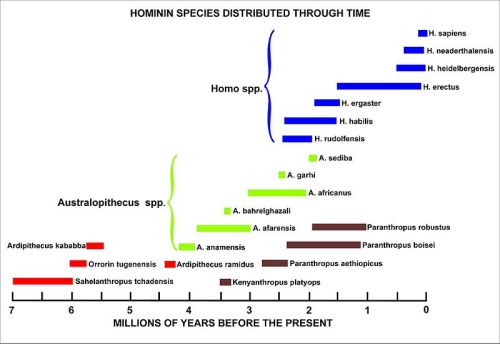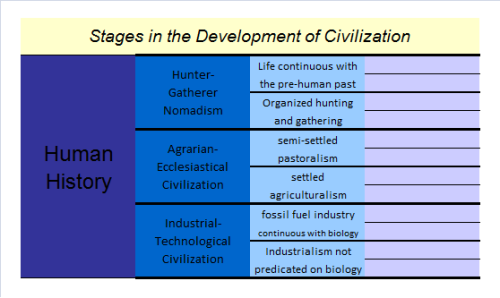Subscribe to the Grand Strategy Newsletter for regular updates on work in progress.
Discord Invitation
Post with 2 notes
Punctuated Equilibrium in Human Development

In my post Living Fossil or Superspecies? I cited the coelacanth as an instance of equilibrium in order to illustration punctuated equilibrium as a model of evolution. (The theory of punctuated equilibrium is especially associated with the work of of Stephen J. Gould and Niles Eldredge.) Then I analogized from the example of the coelacanth to how we might conceptualize a civilization that had endured as long as the coelacanth has endured. Would we call a 400 million year old civilization a living fossil that had presumably stagnated, or would we call it a supercivilization that had overcome every existential risk with which it had been threatened?
One way to think about this would be to observe that the coelacanth is not a chronospecies, i.e., not a result of anagesis that leaves earlier forms of the same species “pseudo extinct”; the coelacanth, as nearly as we can tell, has the same phenotype, and probably nearly the same genotype, as the coelacanth of 400 million years ago. We could apply this same reasoning to civilizations, and distinguish between those with essentially the same institutions over an extended period of time, and those which have experienced the social equivalent of anagesis, such that the earlier forms of this social institution have passed over into pseudoextinction.
It has been argued the phyletic transformation (anagesis) is meaningless under punctuated equilibrium, but I will not enter into this controversy at present. Suffice it to say that I think many different mechanisms are present in both biological and social evolution, and it is a mistake to insist upon a single mechanism. One lineage might develop according to phyletic gradualism while another lineage experiences punctuated equilibrium. This is not a contradiction, it is plurality of evolutionary mechanisms.
In any case, my comparison of the coelacanth to million-year-old supercivilizations raises the question of whether and to what extent the development of human social institutions conform to the model of punctuated equilibrium. Does human civilization, or, more generally, human development (including civilization, but also including pre-civilizational and post-civilizational social institutions), exhibit punctuated equilibrium?
We can begin the seriation of human development with the origins of the genus homo, probably between 5 and 7 million years ago. Early hominids led a life essentially undifferentiated from other primates, although the steady increase in encephalization over millions of years points to an increasing role for consciousness and cognition in hominids (elsewhere I have suggested the encephalization is the great filter).
The earliest hominids, as noted above, lived in a manner undifferentiated from other primates, but when hominids began to use tools, their way of life began to approximate the lifeways of hunter-gatherer nomads. This process of approximation, however, occurred over millions of years. Indeed, the tool kits of early hominid tool users changed almost not at all over a million years, so that the punctuation of inventing tools and tool use was followed by an equilibrium of development.
Encephalization continued to increase through several hominid speciations, and our ancestors eventually mastered fire, group hunting techniques, and language. With these developments the hunter-gatherer nomadic way of life was almost fully in place, and another period of more-or-less equilibrium began with the speciation of homo sapiens, at which point encephalization reaches its present-day level.
The human world of the upper Paleolithic constituted another period of equilibrium, when our ancestors employed their cognitive abilities to surviving the last glacial maximum and expanding into every habitable biome. This expansion was an incremental and gradual process, like encephalization, but the essential way of life of human beings during this period changed almost not at all.
With the end of the ice age and the advent of the Holocene, agriculture, and civilization, human life was radically changed during this punctuation of rapid development, but once agricultural civilization assumed its stable form, this form endured with little change in an equilibrium that endured until the industrial revolution (it endured for about 10,000 years, an order of magnitude less than than approximately 100,000 years of hunter-gatherer nomadism after the homo sapiens speciation). Once again, with the industrial revolution, human life was radically changed during this punctuation of rapid development, but once the way of life was established that characterized industrialized civilization, the gradual and incremental changes that have come about have been consistent with a period of equilibrium.
The perspective I offer here is unambiguously a top-down approach (which is why I sometimes call myself a “non-constructive historian”) and it would be easy for anyone to cite any number of counterexamples or punctuations within the periods of equilibrium I have identified, and vice versa. From the perspective of non-constructive historiography (or, as I have elsewhere called it, formal historiography; formal historiography, of course, also implies the possibility of a constructive formal historiography) it is not a matter of empirical details, but of what model best expresses the character of human development. If it is possible to systematically assume the big picture perspective, then it is important to not be too tied to details, and to see the big picture whole. So, setting aside exceptions and outliers, what is the best model to describe human development? Gradualism and anagesis, or punctuated equilibrium?

infinitedigressions reblogged this from geopolicraticus
infinitedigressions liked this
geopolicraticus posted this